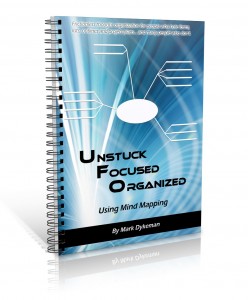 You meet some interesting people using Twitter. Going back a couple years now I ran across a guy named Mark Dykeman (@MarkDykeman). More accurately, he found me, and was kind enough to review Jack’s Notebook. In any event, it’s clear we have similar interests. I’m always keen to hear his unique perspective related to creativity and keep an eye on his Thoughtwrestling blog. I was delighted to hear he’s just completed a new e-book about Mind Mapping titled: “Unstuck, Focused, Organized, using Mind Mapping.”
You meet some interesting people using Twitter. Going back a couple years now I ran across a guy named Mark Dykeman (@MarkDykeman). More accurately, he found me, and was kind enough to review Jack’s Notebook. In any event, it’s clear we have similar interests. I’m always keen to hear his unique perspective related to creativity and keep an eye on his Thoughtwrestling blog. I was delighted to hear he’s just completed a new e-book about Mind Mapping titled: “Unstuck, Focused, Organized, using Mind Mapping.”
The short version of this review is simply, if you are disorganized, either generally, or in some area of your life, this is a highly useful, amazingly practical, heaping helping of fast acting self-help. The book teaches how to de-clutter your mind, capture your ideas, and use Mind Mapping to sort yourself out. If you need sorting, on any level, get this book. Right Away! Click here: http://thoughtwrestling.com/blog/ufo-mind-mapping
Now, there are at least two very good books on Mind Mapping. Tony Buzan, who more or less invented the form, did the seminal book on the subject, the Mind Map Book. Joyce Wycoff has also done a very good one, and Chuck Frey (of Innovation Tools blog fame) has been a consistent advocate. So, my first question was, how is this different? The answer is it’s Personal. Dykeman’s book is not about applying Mind Mapping to business challenges like Wycoff’s. Nor is it a detailed explanation on the psychological grounding, the “why”, of Mind Mapping (although there is some good background). Dykeman’s new book is for people who are at their wit’s end, who don’t know what to do, or are having trouble getting started. It’s a book intended for people with the very messy challenge of — what to do with my life. It’s also a book for those of us who are more visually/diagramatically wired. Not all of us can run our life from a plain old fashioned to-do list!
As I read through this book, doing a few Mind Maps along the way, I am more and more grateful to Mark for putting the effort into writing this piece. It’s elegantly short and to the point, and yet it’s rich with great detail about the how’s and why’s of using Mind Maps for personal problem solving. My only minor critique is that there is not a lot of content about the visual component of Mind Mapping that goes beyond words (and lines). I find that Mind Maps become more powerful when you add that extra visual element. Some folks can add that element as they go because they know how to draw, others can’t. I understand that adding that element might slow down the process and flow Mark is guiding readers towards. Not doing a lot with the visual element is also probably a wise editorial choice in a book of this concise length. There is a great appendix with classic Mind Map instructions (from Buzan) and other resources for those who want the dead-complete guide. But for those who need to get off the dime, soon, this is the book you should buy and use to find your way out of the wilderness.



6 responses to “Revisiting Mind Mapping – an E-book Review”
Just what the doctor ordered. (really)
Gregg, thank you so much for your kind and generous review! And your point for improvement is well taken, perhaps I can work that into an updated version at some point in the future.
Keep on doing the great work, Gregg!
That’s very generous Mark. Best wishes with the excellent book.
Read the book first then choose a good mind mapping software like “Personnal brain “from : http://www.thebrain.com/
If you can organize your computer like your brain, do it with “personnal brain” (it is very easy when you buy your next computer).
Then go to linkedin group :
http://www.linkedin.com/groups?mostPopular=&gid=2215140
to share your experiences with this tool.
Enjoy
Thank you Michel!
Thanks for the review on this…my creative brain is not organized in the traditional way & I am always looking for tools beyond the status quo. 🙂